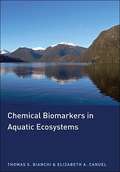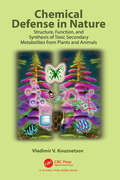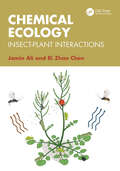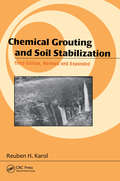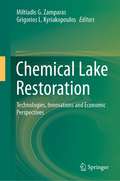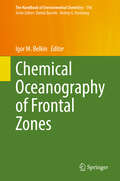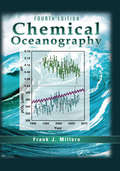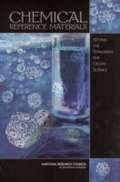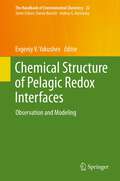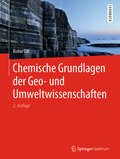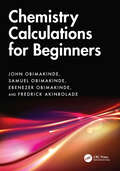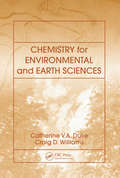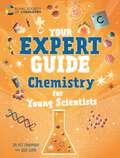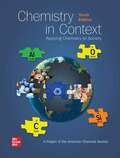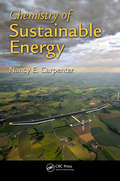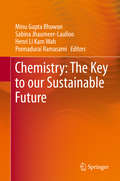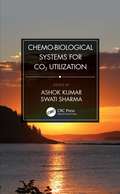- Table View
- List View
Chemical Biomarkers in Aquatic Ecosystems
by Thomas S. BianchiThis textbook provides a unique and thorough look at the application of chemical biomarkers to aquatic ecosystems. Defining a chemical biomarker as a compound that can be linked to particular sources of organic matter identified in the sediment record, the book indicates that the application of these biomarkers for an understanding of aquatic ecosystems consists of a biogeochemical approach that has been quite successful but underused. This book offers a wide-ranging guide to the broad diversity of these chemical biomarkers, is the first to be structured around the compounds themselves, and examines them in a connected and comprehensive way. This timely book is appropriate for advanced undergraduate and graduate students seeking training in this area; researchers in biochemistry, organic geochemistry, and biogeochemistry; researchers working on aspects of organic cycling in aquatic ecosystems; and paleoceanographers, petroleum geologists, and ecologists. Provides a guide to the broad diversity of chemical biomarkers in aquatic environmentsThe first textbook to be structured around the compounds themselvesDescribes the structure, biochemical synthesis, analysis, and reactivity of each class of biomarkersOffers a selection of relevant applications to aquatic systems, including lakes, rivers, estuaries, oceans, and paleoenvironmentsDemonstrates the utility of using organic molecules as tracers of processes occurring in aquatic ecosystems, both modern and ancient
Chemical Defense in Nature: Structure, Function, and Synthesis of Toxic Secondary Metabolites from Plants and Animals
by Vladimir V. KouznetsovThe book examines biological processes vital for organism survival through a chemical lens. Integrating core organic chemistry concepts, such as structural analysis and synthesis, explores how plants and animals produce and utilize toxic organic molecules for growth, survival, and reproduction.The book focuses on the intricate structures, vital functions, and synthesis pathways of toxic secondary metabolites from plants and animals, illustrating toxic substances' intricate chemical relationships and biological significance. The book addresses the following main questions: Why do animals and plants accumulate these toxic substances? What structures do these compounds have? What effects can they have on man? Can they be prepared in the laboratory and used for medicinal purposes?This book delves into the fascinating world of toxic secondary metabolites in plants and animals, bridging chemistry and biology to unravel their roles in survival. With an interdisciplinary approach, it is a valuable resource for researchers, students, and professionals in phytochemistry, organic chemistry, and medical sciences.
Chemical Ecology of Insects: Applications and Associations with Plants and Microbes
by Jun TabataInsects have evolved very unique and interesting tactics using chemical signals to survive. Chemical ecology illustrates the working of the biological network by means of chemical analyses. Recent advances in analytical technology have opened the way to a better understanding of the more complicated and abyssal interactions of insects with other organisms including plants and microbes. This book covers recent research on insects and chemical communications and presents the current status about challenges faced by chemical ecologists for the management of pests in agriculture and human health.
Chemical Ecology: Insect-Plant Interactions
by Jamin Ali Ri Zhao ChenThis textbook provides a comprehensive overview of the principles, methods and applications of chemical ecology, covering such topics as chemical signalling, predator–prey interactions, host plant selection and chemical defence. The book takes the reader through the historical development of the discipline to current state-of-the-art research, delving into recent findings on the role of chemical ecology in conservation and management and exploring how the field may contribute to future innovations in ecological science. A chapter is dedicated to the techniques that have been used in chemical ecology and some success stories.Chemical Ecology: Insect-Plant Interactions is an important resource for advanced undergraduates and postgraduate researchers as well as practitioners in this interdisciplinary field. The book’s layout aligns with the curriculum of chemical-ecology-related disciplines, progressing from basic fundamental principles to a more advanced level. Those studying and researching in ecology, entomology, plant biology and biochemistry will find it invaluable as well as those practising in areas such as agriculture, forestry and pest management.
Chemical Ecology: The Ecological Impacts of Marine Natural Products
by Melany P. Puglisi Mikel A. BecerroDuring the past 20 years, marine chemical ecology has emerged as a respected field of study providing a better understanding of the role natural products play in organisms and their environments. Ample data in this book advocates the conservation of marine environments for future drug discovery efforts while sustaining their overall health. Marine chemical ecology has expanded to include research in the areas of predator–prey interactions, marine microbial chemical ecology, and seasonal and geographical distribution of marine natural products.
Chemical Fundamentals of Geology and Environmental Geoscience
by Robin GillChemical principles are fundamental to the Earth sciences, and geoscience students increasingly require a firm grasp of basic chemistry to succeed in their studies. The enlarged third edition of this highly regarded textbook introduces the student to such 'geo-relevant' chemistry, presented in the same lucid and accessible style as earlier editions, but the new edition has been strengthened in its coverage of environmental geoscience and incorporates a new chapter introducing isotope geochemistry.The book comprises three broad sections. The first (Chapters 1-4) deals with the basic physical chemistry of geological processes. The second (Chapters 5-8) introduces the wave-mechanical view of the atom and explains the various types of chemical bonding that give Earth materials their diverse and distinctive properties. The final chapters (9-11) survey the geologically relevant elements and isotopes, and explain their formation and their abundances in the cosmos and the Earth. The book concludes with an extensive glossary of terms; appendices cover basic maths, explain basic solution chemistry, and list the chemical elements and the symbols, units and constants used in the book.
Chemical Grouting And Soil Stabilization, Revised And Expanded
by Reuben H. KarolFollowing shifting trends from remedial to preventive uses of grouting practices, this third edition covers all aspects of chemical grouting methods and applications. This reference highlights new ground improvement techniques as well as recent innovations in soil modification and stabilization procedures. It considers commercial alternatives to ground improvement, their relative advantages and disadvantages, and the engineering applications to which these methods are suited. Revised and expanded, this new edition assesses the role of new grouting techniques in the containment of hazardous waste and introduces numerous problems to illustrate concepts and facilitate instruction.
Chemical Lake Restoration: Technologies, Innovations and Economic Perspectives
by Miltiadis G. Zamparas Grigorios L. KyriakopoulosThis book aims to structure, in a complete and sequential way, the mainstream technical knowledge which is related to eutrophication control. The book considers the development of innovative technologies for phosphate removal, while supporting the restoration of currently degraded lakes and reservoir systems. In addition, this book contains key-aspects of future benchmark interests being specially framed under the ongoing development of a circular economy. In particular, the book will contribute to a better understanding of the problem of internal P-loads and P-sources disposition towards a more effective control of nutrients’ enrichment in lakes. The chemical routes and environmental fate of such lake nutrients will be viewed in the light of innovative technologies (engineering dimensions) and circular economy perspectives (economics dimensions). The main theme extends to an economic appreciation of environmental polluted aquifers. The book will appeal to an interdisciplinary audience, covering a wide spectrum of scientific fields, such as environment, physical chemistry, surface chemistry, interfacial phenomena, coastal engineering, bio-engineering, environmental policy makers, and economists.
Chemical Oceanography and the Marine Carbon Cycle
by Steven Emerson John HedgesThe principles of chemical oceanography provide insight into the processes regulating the marine carbon cycle. The text offers a background in chemical oceanography and a description of how chemical elements in seawater and ocean sediments are used as tracers of physical, biological, chemical and geological processes in the ocean. The first seven chapters present basic topics of thermodynamics, isotope systematics and carbonate chemistry, and explain the influence of life on ocean chemistry and how it has evolved in the recent (glacial-interglacial) past. This is followed by topics essential to understanding the carbon cycle, including organic geochemistry, air-sea gas exchange, diffusion and reaction kinetics, the marine and atmosphere carbon cycle and diagenesis in marine sediments. Figures are available to download from www. cambridge. org/9780521833134. Ideal as a textbook for upper-level undergraduates and graduates in oceanography, environmental chemistry, geochemistry and earth science and a valuable reference for researchers in oceanography.
Chemical Oceanography of Frontal Zones (The Handbook of Environmental Chemistry #116)
by Igor M. BelkinThis book is a unique and authoritative review of chemical fronts in the world ocean. It includes regional chapters on chemical fronts in all major oceans (Atlantic, Indian, Pacific, Arctic, and Southern) and marginal seas (North Sea, Baltic Sea, Mediterranean Sea, Gulf of Mexico, Yellow Sea, and the East Siberian Sea). Thematic chapters focus on diverse topics such as cross-frontal transfer of nutrients; diapycnal mixing and its impact on nutrient fluxes in western boundary currents (Gulf Stream and Kuroshio); front-driven physical-biogeochemical-ecological interactions; dynamics of coloured dissolved organic matter; pollutant concentration and fish contamination in frontal zones; distribution of microplastics in the ocean, and Lagrangian methods to study the transport of marine litter. This volume will appeal to a broad audience, including researchers, instructors, students, and practitioners of all kinds involved in scientific and applied research, environment protection and conservation, and maritime industries including fisheries, aquaculture, and mining.
Chemical Oceanography: Volume 5, Chemical Oceanography (Harte Research Institute For Gulf Of Mexico Studies Series, Sponsored By The Harte Research Institute For Gulf Of Mexico Studies, Texas A&m University-corpus Christi Ser.)
by Frank J. MilleroOver the past ten years, a number of new large-scale oceanographic programs have been initiated. These include the Climate Variability Program (CLIVAR) and the recent initiation of the Geochemical Trace Metal Program (GEOTRACES). These studies and future projects will produce a wealth of information on the biogeochemistry of the world's oceans. Aut
Chemical Reference Materials for Oceanography: History, Production, and Certification (Springer Oceanography)
by Michio Aoyama Chikako Cheong Akihiko MurataThis open access book explores the history, production, and certification of reference materials for essential parameters in oceanography and provides a comprehensive understanding of them to readers. Because inorganic macro-nutrients, salinity, dissolved oxygen, and carbonate system parameters, including dissolved inorganic carbon, total alkalinity, and pH, are essential parameters in oceanography, they can be used to define biogeographic provinces, monitor ocean health, and detect decadal-scale oceanic climate changes. Without reference materials for these parameters, it would be difficult to produce reliable data sets or long-term baseline studies that are required to verify global change and oceanic stability. The book includes chapters on developing new reference materials for density, dissolved oxygen, dissolved organic carbon, dissolved organic matter, and trace metals, which are also important in oceanographic studies. The lead authors of each chapter regarding these parameters are top scientists in these areas; hence, this is the most comprehensive book of chemical reference materials for ocean science, written by experts in each field. The book is a useful resource for readers to find the latest information and status of certified reference materials (CRM) and reference materials (RM) and of ways to use CRM in their studies. We are in the middle of the United Nations Decade of Ocean Science for Sustainable Development (2021–2030), to which this book makes a timely contribution.
Chemical Reference Materials: Setting The Standards For Ocean Science
by Committee on Reference Materials for Ocean ScienceThe National Academies Press (NAP)--publisher for the National Academies--publishes more than 200 books a year offering the most authoritative views, definitive information, and groundbreaking recommendations on a wide range of topics in science, engineering, and health. Our books are unique in that they are authored by the nation's leading experts in every scientific field.
Chemical Structure of Pelagic Redox Interfaces: Observation and Modeling (The Handbook of Environmental Chemistry #22)
by Evgeniy V. YakushevOver the last few decades many studies have focused on the oxygen depletion of coastal and oceanic waters. An understanding of the processes involved is fundamental to assess the effects of global and climatic changes and to support an ecosystem approach to adaptive environmental management for coastal seas and ocean basins. This timely book presents the state-of-the-art of our knowledge of the nature and chemical structure of redox interfaces in a marine water column, oxygen depletion and connected processes. The structures of the redox layers, including the distribution of certain parameters and microbiological features, are described in detail. The volume also covers studies devoted to the interannual variability of some oxygen-depleted systems, modeling and new developments in observation techniques. In addition, it identifies remaining gaps in our knowledge of the cycling of chemical elements in changing redox conditions. The chapters are based on extensive observational data, collected by the authors during sea and shore expeditions, on archive data, and on a broad range of scientific literature.
Chemical World: Science in Our Daily Lives (Orca Footprints #17)
by Rowena RaeDespite people using both natural and synthetic chemicals with (mainly) good intentions, some chemicals have had unintended negative consequences. Chemical residues have contaminated ecosystems the world over and are compromising the health of many ecosystems, animals and humans. The goal of Chemical World: Science in our Daily Lives is to introduce readers to basic chemistry and chemical history, and to show how chemicals are used for particular reasons but sometimes turn out to be harmful to environmental and human health. It invites readers to take a look at the world around them and ask questions about what’s in their environment and how the things they use and eat every day can affect their own health and the planet’s health. Chemical World: Science in Our Daily Lives explores some of the materials—all of which are made of basic chemical elements—that humans use or come into contact with in their day-to-day lives. Some of these chemicals are naturally occurring—clay, mercury, lead. Others have been synthesized by chemists during the past 150 years and used in a bewildering array of products ranging from roof shingles to toothpaste. Many chemical inventions, as well as naturally produced chemicals, have had profound effects on food supply, developing medicines and creating hosts of useful items for modern life. The epub edition of this title is fully accessible.
Chemische Grundlagen der Geo- und Umweltwissenschaften
by Robin GillChemische Grundlagen sind die Basis für einen großen Teil der Geowissenschaften. Studierende der Geowissenschaften benötigen daher zunehmend ein solides Verständnis der chemischen Grundlagen, um ihr Studium erfolgreich zu absolvieren. Die erweiterte zweite Auflage dieses beliebten Lehrbuchs führt die Studenten in diese "georelevante" Chemie ein, die in demselben klaren und verständlichen Stil wie die Vorauflage präsentiert wird. Die neue Auflage wurde jedoch um den Bereich der Umweltgeowissenschaften erweitert und enthält ein neues Kapitel, in dem die Isotopengeochemie vorgestellt wird.Das Buch umfasst drei große, gegliederte Teile. Der erste (Kapitel 1-4) befasst sich mit der grundlegenden physikalischen Chemie geologischer Prozesse. Der zweite Teil (Kapitel 5-8) führt in die wellenmechanische Sicht auf das Atom ein und erklärt die verschiedenen Arten chemischer Bindungen, die den Materialien der Erde ihre vielfältigen und charakteristischen Eigenschaften verleihen. Die Schlusskapitel (9-11) geben einen Überblick über die geologisch relevanten Elemente und Isotope und erklären ihre Entstehung und ihre Häufigkeit im Kosmos und auf der Erde. Das Buch schließt mit einem umfangreichen Glossar von Begriffen; die Anhänge behandeln grundlegende Mathematik, erklären die grundlegende Lösungschemie und listen die chemischen Elemente und die im Buch verwendeten Symbole, Einheiten und Konstanten auf.Die Übersetzung wurde mit Hilfe von künstlicher Intelligenz (maschinelle Übersetzung durch den Service DeepL.com) angefertigt. Da die anschließende Überprüfung hauptsächlich im Hinblick auf inhaltliche Gesichtspunkte erfolgte, kann sich der Text des Buches stilistisch von einer konventionellen Übersetzung unterscheiden. Springer Nature arbeitet bei der Publikation von Büchern kontinuierlich mit innovativen Technologien, um die Arbeit der Autoren unterstützen.
Chemistry Calculations for Beginners
by John Obimakinde Samuel Obimakinde Ebenezer Obimakinde Fredrick AkinboladeWith decades of combined experience as science teachers at both school and undergraduate levels, the authors have recognised that one of the greatest challenges faced by students studying chemistry is grasping the complexity of the numerous numerical problems found in most parts of the subject. This text is crafted to provide a clear and accessible pathway to overcoming this challenge by assisting students, especially novices or those with minimal knowledge of the subject, in performing chemistry calculations. The content covers fundamental calculations crucial to understanding the principles of chemistry, making it an invaluable tool for students aiming to excel in their studies.Key features Designed with a student-friendly approach, including detailed explanation of chemical concepts underlying each type of calculation, step-by-step explanations, alternative methods for solving problems, numerous practice exercises, answers to practice exercises and appendices The book is tailored to suit various curricula, ensuring relevance for a diverse audience Encompasses a wide range of calculations, offering students a thorough understanding of essential chemistry concepts Serves as an excellent resource for exam preparation and equips students with skills applicable to future scientific endeavours. Employs straightforward language to ensure ease of understanding for beginners Uses IUPAC conventions, underscoring the universal nature of chemistry
Chemistry for Environmental and Earth Sciences
by Catherine Vanessa Duke Craig Denver WilliamsChemistry for Environmental and Earth Sciences focuses on the chemistry and processes behind environmental issues such as global warming, ozone depletion, acid rain, water pollution, and soil contamination. Accessible to science as well as non-science majors, this textbook is divided into four intuitive chapters: Fire, Earth, Water, and Air. It uses worked examples and case studies drawn from current applications along with clear diagrams and concise explanations to illustrate the relevance of chemistry to geosciences. In-text and end-of-chapter questions with complete solutions also help students gain confidence in applying concepts from this book towards solving current, real-world problems.
Chemistry for Young Scientists (Your Expert Guide #2)
by Dr Dr Kit ChapmanFrom a top expert in the world of science comes this definitive and clear guide to chemistry, published in partnership with the Royal Society of Chemistry.In Your Expert Guide: Chemistry for Young Scientists, discover the foundations of this crucial and exciting branch of science. Learn to think like a chemist, stay safe in the lab and explore the chemical building blocks of everything around you - from the air we breathe and the water we drink, to rockets, smartphones, stars and our bodies. Get an expert view of how chemistry underpins our understanding of matter on Earth and beyond!Written by Dr Kit Chapman, award-winning science journalist, academic at Falmouth University and global science communicator. Published in partnership with The Royal Society of Chemistry, the internationally renowned nonprofit organisation with the same mission since 1841: to advance excellence in the chemical sciences. With approachable artwork by Dao Linh, see the elements come alive for curious readers aged 8+.Books in the Your Expert Guide series:With Royal Society of Chemistry: The Periodic Table / Chemistry for Young ScientistsWith Royal Society of Biology: The Human Body / Biology for Young ScientistsWith Institute of Physics: The Universe / Physics for Young Scientists
Chemistry in Context: Applying Chemistry to Society
by Bradley D. Fahlman American Chemical Society Staff Kathleen Purvis-Roberts John S. Kirk Resa M. Kelly Patrick L. DaubenmireFollowing in the tradition of the first nine editions, the goal of this successful, issues-based textbook, Chemistry in Context, is to establish chemical principles on a need-to-know basis for non-science majors, enabling them to learn chemistry in the context of their own lives and significant issues facing science and the world. <p><p>The non-traditional approach of Chemistry in Context reflects today's technological issues and the chemistry principles within them. Global warming, alternate fuels, nutrition, and genetic engineering are examples of issues that are covered in Chemistry in Context.
Chemistry of Sustainable Energy
by Nancy E. CarpenterUnderstanding the chemistry underlying sustainable energy is central to any long-term solution to meeting our future energy needs. Chemistry of Sustainable Energy presents chemistry through the lens of several sustainable energy options, demonstrating the breadth and depth of research being carried out to address issues of sustainability and the gl
Chemistry: The Key To Our Sustainable Future
by Henri Li Kam Wah Ponnadurai Ramasami Minu Gupta Bhowon Sabina Jhaumeer-LaullooChemistry: The Key to our Sustainable Future is a collection of selected contributed papers by participants of the International Conference on Pure and Applied Chemistry (ICPAC 2012) on the theme of "Chemistry: The Key for our Future" held in Mauritius in July 2012. In light of the significant contribution of chemistry to benefit of mankind, this book is a collection of recent results generated from research in chemistry and interdisciplinary areas. It covers topics ranging from nanotechnology, natural product chemistry to analytical and environmental chemistry. Chemistry: The Key to our Sustainable Future is written for graduates, postgraduates, researchers in industry and academia who have an interest in the fields ranging from fundamental to applied chemistry.
Chemo-Biological Systems for CO2 Utilization
by Ashok Kumar Swati SharmaChemo-Biological Systems for CO2 Utilization describes the most recent advanced tools and techniques for carbon dioxide capture and its utilization. It discusses and compares the advantages of different systems and aids researchers and industrialists in understanding energy generation in the form of biofuels, bioelectricity, or biogas using chemicals; nanomaterials; and microbial, enzymatic, and chemo-enzymatic-integrated systems. It describes the importance and utilization of CO2 in living systems, and provides an overview of the various fundamental methods, policies, and techniques involved in CO2 conversion. Emphasis is placed on the production of value-added products using CO2, including biomethanol, industrial carbonates, and liquid or gaseous fuels. Features: Explains the correlations between microbial, biological, and chemical products and their roles in the conversion of CO2 into usable energy and related products. Being suitable for a broad audience, it addresses fundamental treatment methods for reusing environmental waste materials. Aids in decision-making and policy planning for environmental professionals. The information provided throughout this book will help researchers and professionals working in various industries to better understand the conversion of CO2 into energy-based products. Chemo-Biological Systems for CO2 Utilization also serves as a useful guide to seek alternative methods for clean energy and mitigating global climate change.
Chemostratigraphy Across Major Chronological Boundaries (Geophysical Monograph Series #240)
by Alcides N. Sial Claudio Gaucher Muthuvairavasamy Ramkumar Valderez Pinto FerreiraExploring environmental changes through Earth’s geological history using chemostratigraphy Chemostratigraphy is the study of the chemical characteristics of different rock layers. Decoding this geochemical record across chronostratigraphic boundaries can provide insights into geological history, past climates, and sedimentary processes. Chemostratigraphy Across Major Chronological Boundaries presents state-of-the-art applications of chemostratigraphic methods and demonstrates how chemical signatures can decipher past environmental conditions. Volume highlights include: Presents a global perspective on chronostratigraphic boundaries Describes how different proxies can reveal distinct elemental and isotopic events in the geologic past Examines the Archaean-Paleoproterozoic, Proterozoic-Paleozoic, Paleozoic-Mesozoic, and Mesozoic-Paleogene boundaries Explores cause-and-effect through major, trace, PGE, and REE elemental, stable, and radiogenic isotopes Offers solutions to persistent chemostratigraphic problems on a micro-global scale Geared toward academic and researchgeoscientists, particularly in the fields of sedimentary petrology, stratigraphy, isotope geology, geochemistry, petroleum geology, atmospheric science, oceanography, climate change and environmental science, Chemostratigraphy Across Major Chronological Boundaries offers invaluable insights into environmental evolution and climatic change.
Chemtrails, HAARP, and the Full Spectrum Dominance of Planet Earth
by Elana FreelandWe are entering a Space Age, but not the kind President Kennedy originally envisioned. This Space Age is replacing resource wars and redefines planet earth as a "battlespace" in accordance with the military doctrine of "Full-Spectrum Dominance."This book examines how chemtrails and ionispheric heaters like the High-frequency Active Auroral Research Project (HAARP) in Alaska services a full-spectrum dominance. This "Revolution in Military Affairs" needs an atmospheric medium to assure wireless access to the bodies and brains of anyone on Earth--from heat-seeking missiles to a form of mind control.How sinister are these technologies? Are we being prepared for a "global village" lockdown? The recent release of NSA records have reminded Americans that "eyes in the sky" are tracking us as supercomputers record the phone calls, e-mails, internet posts, and even the brain frequencies of millions.Elana M. Freeland's startling book sifts through the confusion surrounding chemtrails-versus-contrails and how extreme weather is being "geo-engineered" to enrich disaster capitalists and intimidate nations.A deconstruction of Bernard J. Eastlund's HAARP patent points to other covert agendas, such as a global Smart Grid infrastructure that enables access to every body and brain on Earth, a "Transhumanist" future that erases lines between human and machine, and Nanobiological hybrids armed with microprocessers that infest and harm human bodies.
